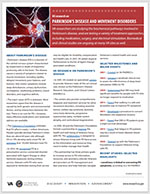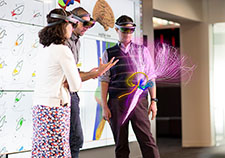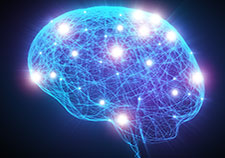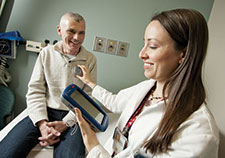Office of Research & Development |
 |
Parkinson's disease (PD) is a disorder of the central nervous system characterized by impairment or death of dopamine-producing cells in the brain. The disease causes a variety of symptoms related to muscle movement, including rigidity, delayed movement, poor balance, and tremors. Non-motor symptoms of PD include sleep disturbances, urinary dysfunction, constipation, swallowing problems, mood disorders, and cognitive deficits.
The exact cause of PD is unknown. Most researchers agree that the disease is caused by both genetic and environmental factors, and by interactions between the two. There is no cure for PD; however, many effective medications and treatment options are available.
The Parkinson’s Foundation estimates that PD affects nearly 1 million Americans. People typically develop Parkinson's when they are about 60 years old, although 5% to 10% develop early-onset disease. VA estimates that 110,000 Veterans have PD.
In 2010, VA recognized PD as a presumptive service-connected disorder associated with Agent Orange or other herbicide exposures during military service. Veterans with PD who were exposed to herbicides during their service may be eligible for disability compensation and health care. In 2021, VA added atypical Parkinsonism to the list of conditions presumptively associated with Agent Orange exposure. Atypical Parkinsonism refers to a group of diseases with Parkinson’s-like symptoms that do not respond well to drug treatment.
In 2020, VA and the Parkinson Foundation formed a partnership to improve the health and well-being of Veterans living with PD. The collaboration is designed to ensure Veterans living with PD have access to the information and resources they need to better manage their health.
The partnership has three primary goals: to increase access to PD information, resources, and providers; educate Veterans and providers on PD management and best practices; and help Veterans navigate Parkinson’s-related health and social services.
In 2001, VA created six specialized centers to provide Veterans state-of-the-art clinical care, education, research, and advocacy for Parkinson's disease.
Known as the Parkinson's Disease Research, Education, and Clinical Centers (PADRECC), they are located in Philadelphia, Richmond, Virginia, Houston, Los Angeles, San Francisco, and the Seattle/Portland area. The centers also provide comprehensive diagnosis and treatment services for other movement disorders, including essential tremor, restless leg syndrome, dystonia, Lewy body disease, progressive supranuclear palsy, multiple system atrophy, and corticobasal degeneration.
Researchers at these sites are studying the biochemical pathways involving dopamine and testing a variety of treatment approaches for PD, including medication, surgery, and electrical stimulation. Biomedical and clinical studies on PD are ongoing at many other VA sites as well.
If you are interested in learning about joining a VA-sponsored clinical trial, visit our research study information page.
PD may be related to gut pathogens—In 2020, researchers from the VA Puget Sound Health Care System and other institutions found that people with PD had an overabundance of opportunistic pathogens, compared to control subjects. Opportunistic pathogens are microorganisms that do not usually cause harm to healthy hosts but may be harmful for patients whose immune systems are weakened or who have other underlying health problems.
The research team identified 15 types of gut microorganisms associated with PD. The association appeared in three different patterns of co-occurring groups. The team recommended further studies to determine whether these microorganisms could play a role in PD.
Lewy body pathology associated with contact sports—Mounting evidence suggests that repetitive head trauma from contact sports and other exposures is associated with a neurodegenerative disease called chronic traumatic encephalopathy (CTE). A 2018 study at the VA Boston Healthcare System and Boston University suggests that contact athletes may also be at increased risk for Lewy body dementia (LBD). Most people with PD have Lewy bodies—protein deposits—in their brains, which cause the motor symptoms of PD.
The researchers examined 694 brains from three biorepositories, including the VA Biorepository Brain Bank. They found that athletes who played eight or more years of contact sports had the greatest risk of developing LBD—six times higher than those who did not play. Athletes with both CTE and LBD were significantly more likely to have dementia and symptoms of PD than those with just CTE.
LBD is a disease associated with abnormal deposits of a protein called alpha-synuclein in the brain. These abnormal deposits can cause problems with movement, cognition, depression, sleep, and visual hallucinations.
Football and auto injuries may raise risk for PD—A "rear-end" accident in which the driver’s head slams against the steering wheel, or a helmet-to-helmet hit with an opponent on the football field can increase the risk of PD if a concussion results, according to a 2018 study.
Researchers at the San Francisco VA Medical Center and the University of California looked at the records of more than nearly 326,000 Veterans—half of whom experienced a traumatic brain injury (TBI). They found Veterans who had a mild TBI (known as a concussion) had a 56% greater risk of developing PD than those without TBI history.
The study highlighted the importance of TBI prevention, long-term follow-up of Veterans with TBI, and the need to determine modifiable risk factors for PD.
Deep brain stimulation (DBS) is a surgical procedure used to treat movement disorders, especially those related to PD. DBS uses an implanted, battery-operated device to deliver electrical stimulation to targeted areas in the brain that control movement. DBS blocks abnormal nerve signals that cause tremors and other neurological conditions.
The first experimental DBS implants took place in 1987, and the Food and Drug Administration approved its use in 2002.
DBS versus medical therapy—In early 2009, VA and the National Institutes of Health completed the first large-scale trial of DBS. Cooperative study #468 was conducted at seven VA medical centers and six university hospitals. Phase I compared the effectiveness of DBS and comprehensive medical therapy as treatments for PD. Phase II compared bilateral DBS at two areas of the brain—the subthalamic nucleus (STN) and the globus pallidus (GPi)—to determine the most effective brain site for surgical intervention
The researchers found DBS patients had better control of their limbs and could walk better than patients on medication. They also found that older patients, who had previously been excluded from treatment, benefited from DBS as much as younger patients. Even though DBS appeared to be riskier than drug therapy, it may hold benefits for PD patients who no longer respond to medication, said the researchers.
DBS follow-up study—A 2018 study showed CSP #468 changed how DBS was administered for PD patients. The researchers wanted to find out which regions of the brain were targeted for DBS stimulation before and after the 2009 study. They found that while the STN was still the most common target of DBS, targeting of the GPi increased dramatically since the initial report was released. The GPi is involved in the regulation of voluntary movement—damage to this brain structure has been shown to cause movement problems such as tremors. After the 2009 report, GPi stimulation increased from 5% to 37% of DBS treatments for PD. GPi targeting was most often selected for patients with poorer cognitive and mood performance before treatment.
Different DBS targets offer similar results—A 2019 literature review that included an Edward Hines, Jr. VA Hospital researcher found that DBS targeting the STN and GPi brain regions had similar results. Both forms of DBS were effective at reducing tremor in PD patients, according to multiple studies. However, the degree of tremor suppression in STN versus GPi targeting was equivalent. The results suggest that DBS target selection should focus on other comorbidities, such as cognitive impairment or mood disorders, since both targets are equally effective at alleviating tremor, according to the researchers.
Studying gait and balance impairment—In 2019, researchers at the Cleveland FES Center, a consortium including the Louis Stokes Cleveland VA Medical Center and four partner organizations, engaged in three research projects relating to Parkinson’s. These studies examined how patients perceive their environment, how they perceive motion through an environment, and how they navigate an environment. All the studies used DBS in hopes of understanding how Parkinson’s impairs walking, why PD patients can veer to the side and sometimes freeze, and how DBS affects eye movements.
DBS linked to longer survival—In a 2017 study, researchers at the Edward Hines, Jr. VA Hospital in Illinois found that patients who received DBS had a modest survival advantage compared with patients treated with medication.
The research team identified 611 Veterans with PD who had undergone DBS. They compared this group with a matched group of Veterans with PD that were not treated with DBS. They found PD patients treated with DBS survived an average of 6.3 years after their surgery, compared to 5.7 years for non-DBS patients. The average age of Veterans in the study was 69.
While the survival advantage in the DBS group was modest, said the researchers, DBS patients' quality of life was improved because treatment can help control symptoms such as tremors and rigidity.
Research has demonstrated the benefits of exercise for patients with PD. Not only have exercise programs been shown to improve motor function and reduce the risk of falls, but they also improve overall quality of life and possibly slow the course of the disease.
Fatigue is associated with lower diastolic blood pressure—Fatigue is a common debilitating symptom in PD. A 2019 study by researchers at the VA Ann Arbor Health Care System and University of Michigan found that symptoms of fatigue in PD patients were associated with small reductions in diastolic blood pressure throughout the day. Diastolic blood pressure measures pressure in the arteries when the heart rests between beats.
The investigators assessed hourly home blood pressures in 35 people with PD. They then asked the study participants to describe any symptoms of fatigue. The patients with fatigue symptoms had lower mean diastolic blood pressure than those without. The differences in pressure were most notable in the morning.
Fatigue is a complex condition. Understanding the mechanisms that underlie PD fatigue can help scientists find new treatment approaches, wrote the researchers. Fatigue experienced by PD patients could be a clinical manifestation of low blood pressure, they say.
Tango lessons can help PD patients—In 2017, researchers at the Atlanta VA Medical Center published a study that found changes in muscle coordination were linked to improved muscle performance after a dance-based intervention for people with mild to moderate PD.
Researchers taught an adapted version of the Argentine tango to 20 people with mild to moderate PD. Over three weeks, participants completed 15 dance lessons, each lasting 90 minutes.
The investigators found that the classes triggered improvements in neuromuscular control, improving participants’ ability to walk and regain balance.
Walking improves PD symptoms—A 2014 study led by researchers with the Iowa City VA Health Care System and the University of Iowa found that patients who walked briskly for 45 minutes, three times a week, showed improvements in their Parkinson's symptoms. They were also less depressed and less tired.
The study suggests walking provides a safe and easily accessible way of improving the symptoms of PD. While previous studies had shown that moderately strenuous exercise is helpful, this research showed that even moderate walking can make a significant difference.
PD patients with sleep disorder have poorer mental function—Rapid eye movement (REM) sleep behavior disorder affects 33% to 46% of PD patients. It is a condition in which people physically act out vivid, often unpleasant dreams. Patients may call out or laugh during REM sleep and experience sudden or violent arm and leg movements. During the REM cycle, patients typically are unable to move their arms and legs.
In a 2020 study, researchers at the VA San Diego Medical Center compared cognitive performance between PD patients with and without REM sleep behavior disorder. They found that PD patients with disordered sleep had poorer executive functioning and learning performance. Patients also had poorer neuropsychological functioning and medication management skills.
According to the research team, these results underscore the importance of assessing PD patients for sleep disorders.
Loneliness linked to worsening of PD symptoms—A 2020 study by researchers at the Southwest VA PADRECC and other institutions found that people with PD who were socially isolated were 55% more likely to experience more severe symptoms than those who were not lonely.
The team analyzed data from more than 1,500 people with PD. Participants who reported being most lonely also reported exercising less, were less likely to follow a healthy diet, and experienced a lower quality of life. The negative impact of loneliness on symptom severity was as large as the positive effect PD patients get from exercise.
The team has recently sent out a new survey to study participants to collect data about how the COVID-19 pandemic has affected their symptoms.
Antipsychotic medications for PD—Approximately 60% of people with PD experience psychosis at some point in time. Psychosis is associated with decreased quality of life, caregiver burden, agitation and aggression, sleep disruption, hospitalization, institutionalization, and increased mortality in PD patients.
The most commonly used antipsychotic drug for PD patients with psychosis is quetiapine (sold as Seroquel), but evidence is lacking on its value. Pimavanserin (sold as Nuplazid) is a newer drug that was approved by the Food and Drug Administration, but questions remain about its efficacy and safety.
The Philadelphia PADRECC has begun a six-year study that will enroll approximately 360 patients with PD to test whether pimavanserin is superior to quetiapine, and if not, whether quetiapine (a less expensive medication) is no worse than pimavanserin. Each VA PADRECC and approximately 20 other VA PD consortium sites will participate. The study is currently scheduled to be completed in 2025.
ADHD drug may help treat PD—In 2018, researchers at the Durham VA Health Care System found that the medication atomoxetine (sold as Strattera) has potential for treating executive dysfunction in PD patients. Executive function refers to the cognitive processes involved in planning, organizing, and completing tasks. PD patients typically have difficulties with attention, inhibition control, decision making, and other tasks.
The research team conducted a literature review that showed atomoxetine improved several markers of executive dysfunction in patients with PD, including impulsivity, risk-taking, and global cognition. The drug was generally well tolerated, with some reports of gastrointestinal problems or insomnia.
Atomoxetine is commonly used to treat attention deficit/hyperactivity disorder, a common neurodevelopmental disorder in children that can continue into adulthood.
A large international study including multiple VA researchers found that a gene previously linked to PD is also associated with PTSD risk. The researchers examined the genomes of over 30,000 participants with PTSD and 170,000 controls. They identified three new locations on the genome where gene variations affect a person’s risk for PTSD, one of which is also associated with PD risk. The identified gene, PARK2, is involved with dopamine production. The findings suggest that genetic risk factors for the two diseases could be related.
In 2019, researchers at the VA Greater Los Angeles Healthcare System published the results of a study in which they looked at a new method of PD disease management. They found that a nurse-led chronic care model called Care Coordination for Health Promotion and Activities in Parkinson's Disease (CHAPS) led to improved care for PD patients.
Half of the patients in the study were treated using the CHAPS model, and the rest received usual PD care. The CHAPS group had substantially higher adherence to quality-of-care indicators including assessment of symptoms, counseling, and palliative care. Of eight secondary outcomes, the only patient-centered improvement was on a depression screen in the CHAPS group.
According to the researchers, while the model shows potential to improve PD treatment, more refinement is needed so that patient-centered outcomes can be improved.
Synergy of pandemics-social isolation is associated with worsened Parkinson severity and quality of life. Subramanian I, Farahnik J, Mischley LK. Social isolation was associated with greater patient-reported PD severity and lower quality of life, although it is unclear whether this is the cause or a consequence of the disease. NPJ Parkinsons Dis. 2020 Oct 8;6:28.
REM sleep behavior disorder in Parkinson’s disease: effects on cognitive, psychiatric, and functional outcomes. Mahmood Z, Van Patten R, Nakhia MZ Twamley EW, Filoteo JV, Schiehser DM. Disordered sleep is linked to poorer mental function in patients with PD. J Int Neuropsychol Soc. 2020 Oct;26(9):894-905.
Characterizing dysbiosis of gut microbiome in PD: evidence for overabundance of opportunistic pathogens. Wallen ZD, Appah M, Dean MN, Sesler CL, Factor SA, Molho E, Zabetian CP, Standaert DG, Payami H. There is a significant overabundance of a cluster of opportunistic pathogens in the guts of persons with PD. NPJ Parkinsons Dis. 2020 Jun 12;6:11.
Fatigue in Parkinson’s disease associates with lower ambulatory diastolic blood pressure. Kotagai V, Szpara A, Albin RL, Bohnen NI. Fatigue in PD may be a clinical manifestation of low-grade systemic hypotension. J Parkinsons Dis. 2019;9(3):575-581.
Participant and study partner reported impact of cognition on functional activities in Parkinson’s disease. Cholerton B, Poston KL, Tian L, Quinn JF, Chung KA, Hiller AL, Hu S-C, Specketer K, Montine TJ, Edwards KL, Zabetian CP. For participants with PD in the early stages of cognitive decline, self-rating may be more sensitive to the impact of cognitive changes on instrumental activities of daily living function than ratings made by a knowledgeable study partner. Mov Disord Clin Pract. 2019 Dec 14;7(1):61-69.
International meta-analysis of PTSD genome-wide association studies identifies sex- and ancestry-specific genetic risk loci. Nievergelt CM, Maihofer AX, Klengel T, Atkinson EG, Chen CY, Choi KW, Coleman JRI et al. Nat Commun. 2019 Oct 8;10(1):4558.
Randomized trial of care management to improve Parkinson disease care quality. Conner KI, Cheng EM, Barry F, Siebens HC, Lee ML, Ganz DA, Mittman BS, Connor MK, Edwards LK, McGowan MG, Vickrey BG. A nurse-led chronic care management intervention substantially increased adherence to PD quality of care indicators among Veterans with PD. Neurology. 2019 Apr 16;92(16):e1831-e1842.
STN vs. GPi deep brain stimulation for tremor suppression in Parkinson disease: A systematic review and meta-analysis. Wonk JK, Cauraugh JH, Ho KWH, Broderick M, Ramirez-Zamora A, Almeida L et al. Both STN and GPi deep brain stimulation had similar results for treating PD tremors. Parkinsonism Relat Disord. 2019 Jan;58:56-62.
The role of Atomoxetine for Parkinson disease-related executive dysfunction: a systematic review. Warner CB, Ottman AA, Brown JN. In patients with Parkinson’s disease, treatment with atomoxetine resulted in improvements in several markers of executive dysfunction including impulsivity, risk taking, and global cognition. J Clin Psychopharmacol. 2018 Dec;38(6):627-631.
Lewy body pathology and chronic traumatic encephalopathy associated with contact sports. Adams JW et al. Contact sports athletes may be at increased risk for Lewy body disease, which can cause PD. J Neuropathol Exp Neurol. 2018 Sep;77(9):757-768.
Mild TBI and risk of Parkinson disease: a Chronic Effects of Neurotrauma Consortium study. Gardner RC, Byers AL, Barnes DE, Li Y, Boscardin J, Yaffe K. Among military Veterans, mild TBI is associated with 56% increased risk of PD, even after adjusting for demographics and medical/psychiatric comorbidities. Neurology. 2018 May 15;90(20):e1771-e1779.
Before and after the Veterans Affairs Cooperative Program 468 study: Deep brain stimulator target selection for treatment of Parkinson’s disease. Southwell DG, Rutkowski MJ, San Luciano M, Racine C, Ostrem J, Sstarr PA, Larson PS. GPi targeting for deep brain stimulation of PD increased after CSP 468 was published. Parkinsonism Relat Disord. 2018 Mar;48:40-44.
Survival in patients with Parkinson’s disease after deep brain stimulation or medical management. Weaver FM, Stroupe KT, Smith B, Gonzalez B, Huo Z, Cao L, Ippolito D, Follett KA. DBS is associated with a modest survival advantage when compared with a matched group of patients who did not undergo DBS. Mov Disord. 2017 Dec; 32(12):1756-1763.
Increased neuromuscular consistency in gait and balance after partnered, dance-based rehabilitation in Parkinson's disease. Allen JL, McKay JL, Sawers A, Hackney ME, Ting LE. Clinically meaningful improvements in behavioral measures of balance, gait, and disease symptoms in PD patients were noted after three weeks of daily adapted tango classes. J Neurophysiol. 2017 Jul 1;118(1):363-373.

Download PDF
 Brain organoids: Emerging method to study brain diseases
Brain organoids: Emerging method to study brain diseases
 Gaining insight into Parkinson's
Gaining insight into Parkinson's
 Home use test of brain-computer interface for ALS patients yields 'complicated' results
Home use test of brain-computer interface for ALS patients yields 'complicated' results
 Deep brain stimulation linked to longer survival for Parkinson's patients
Deep brain stimulation linked to longer survival for Parkinson's patients